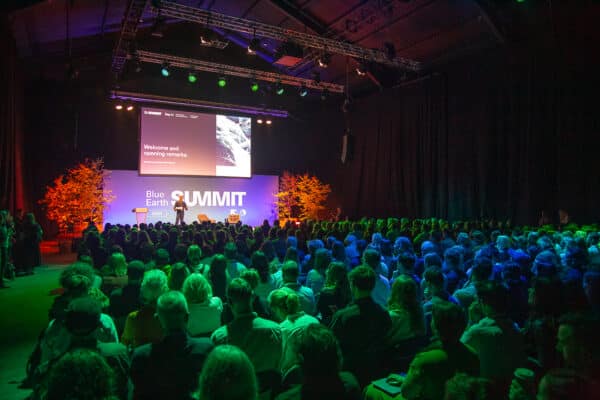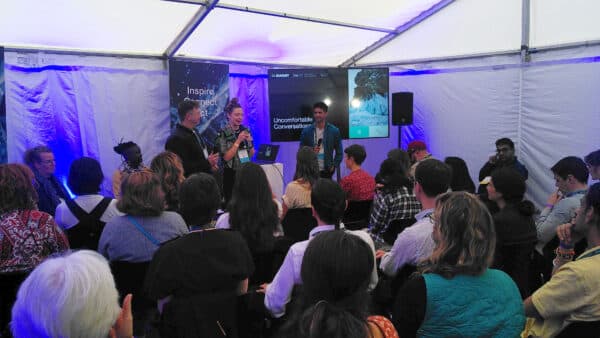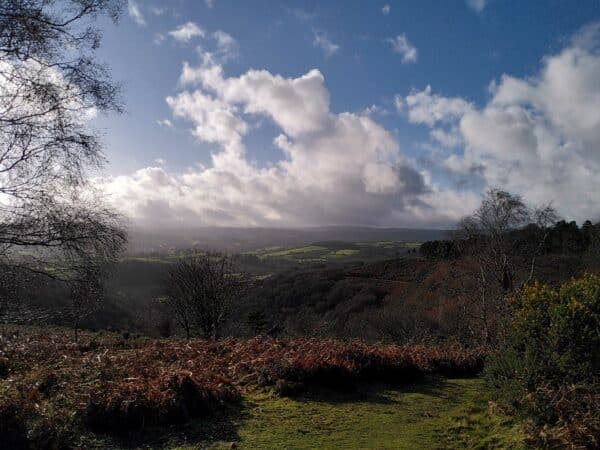Dragons, phones, disconnection and uncomfortable conversations… In a full and thought-provoking day one at the Blue Earth Summit, it was clear how important narrative is becoming for all businesses in the current social and environmental context.
As with any sustainability discussion, there was no getting away from the challenges – but it was also clear how important the story is. It’s vital, not just in communicating what you’re doing, but to giving direction, clarity, energy and momentum around what you’re doing too.
What's the difference?
This year is the third Blue Earth Summit – an event all about “making a difference to the way the world works, a real difference to people and planet”, as host Keme Nzerem told us as the conference started rolling.

First up on the Forum Stage was entrepreneur, investor and ‘dragon’ of the BBC’s Dragon’s Den, Deborah Meadon. She talked about how much her ideas of sustainability have changed over 45 years of doing business. But she still believes “you should do as much as you can, but you can only do what you can do”.
"Ditching your competitive advantage and collaborating with competitors may do more than make business feel a little uncomfortable."
As for talking about what you do, don’t hide it away, she insists. It should be abundantly clear to all of your audiences “what your version of sustainability is; what you version of ethics is”.
If it doesn’t make you uncomfortable, it’s not enough
Meadon is part of the Save our Wild Isles campaign, which has created a series of videos focused on how business can halt biodiversity loss and restore what’s been lost. In one video, Barratt Homes chief executive, David Thomas, tells us: “This is not like normal business. In normal business, people can be a bit secretive and they want to ensure they’ve got a competitive advantage. This is not what this is about.”
Ditching your competitive advantage and collaborating with competitors may do more than make business feel a little uncomfortable.
But spend any time considering the level of challenge on climate change, or on addressing deep rooted social inequality, and the realisation quickly follows that this is no time to feel comfortable with continuing as ‘normal’.
Talking of uncomfortable, late afternoon saw the Uncomfortable Conversations workshop, which featured John Brown of Don’t Cry Wolf on what exactly B Corp stands for now, and Alexandra Pimor at the Earth Law Center on accepting we are the problem, then choosing our response, from fight to flight to saying “fine, then” and getting to work on solving the problems.

The session explored in more detail the need to challenge accepted ideas and ways of thinking, that also took on the limits of binary thinking, the othering of nature and aggressive development.
Representation and connection
David Olusoga delivered the summit lecture, with a rapid run through of population dynamics and the historic reasons why the UK scores so low compared to the rest of Europe on feelings of connection or affinity with nature. This disconnect with the natural world is even more acute in minority ethnic groups.
 This disconnect, Olusoga argued, is the product of industrialisation – in 1851, “the UK became the first majority urban society”. And the enclosure of land to create a system of land ownership – fuelled by colonialism – that is “concentrated and frankly secretive”.
This disconnect, Olusoga argued, is the product of industrialisation – in 1851, “the UK became the first majority urban society”. And the enclosure of land to create a system of land ownership – fuelled by colonialism – that is “concentrated and frankly secretive”.
Perhaps most important of all, is the lack of social acceptance that “the empire happened here, not just there”.
If this makes you feel uncomfortable and you’re wondering why it matters here, we can only begin to address what the challenge is, if we understand how we got here and what affects the people we’re talking to.
Olusoga challenged attendees with the prospect that a growing number of their audience would be from social groups that currently feel the least affinity with nature – “a significant challenge to the business models of purpose-led businesses”.
How do we connect on sustainability?
“When we were in the beginning phases, we’d be approached behind the scenes by people from big technology firms because they wanted to understand how we were making sustainability a core part of the business"
What’s the story?
I caught up with Tessa Wernink, at the Undercover Activist, ahead of her appearance on a panel discussing corporate activism. Tessa was part of the team that launched Fairphone 10 years ago.
We talked the tech sector and the fact that no successful direct competitor to Fairphone – a phone designed around sustainability in sourcing, repair, lifespan and use – has emerged over the past decade.
She highlighted the lack of story competitor products had – when they did emerge – and how they’d failed to get market traction.
In fact, big tech companies were getting in touch with Fairphone in those early days, eager to know how it should be done. “When we were in the beginning phases, we’d be approached behind the scenes by people from big technology firms because they wanted to understand how we were making sustainability a core part of the business rather than an add-on, which is what was happening.”
That is the story for today.
How is this new way of doing business, that is socially and environmentally positive, becoming a core part of your business?
And how can you tell that story so that it resonates and reaches the audience you’re talking to?
+
Image credits
Blue Earth Summit
Paul Dicken
‘Open’ image: Ekaterina Belinskaya via Pexels